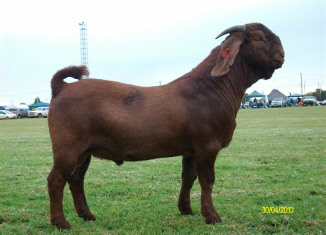THE KALAHARI REDS
Stud Nr: KR 3
Stud Nr: KR 3
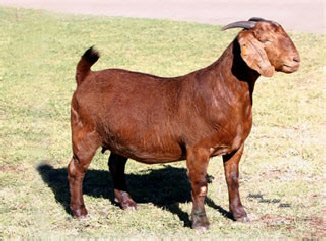

Rubie -
After
having achieved good success in the boergoat breeding we took the challenge
of breeding a new variation of colour and the Kalahari Reds were developed.
Interest in the Kalahari Red breed is widespread, and has come from a far
afield as Australia, Brazil and the USA. The hardiness of the breed, its
excellent walking ability and good mothering attributes make it ideally
suited to the harsh conditions predominant in large parts of South Africa,
Australia, Brazil and the USA. The animals are fully pigmented and therefore
able to endure heat and strong sunshine, while their earthy colour serves
to camouflage them from predators. Kalahari Reds are less susceptible to
diseases and need to be inoculated and dosed far less than other breeds.
All of theses easy-care qualities make the Kalahari Reds a popular
choice in areas where farming is less labour intensive. Breeders select
Kalahari Reds for their natural qualities and for functional effectiveness.
The ewes are fertile and produce plenty of milk. They both lamb and raise
their kids in the veld. Breeders tend to select specifically for twins,
which are normally of equal strength. To prevent kid mortalities as a result
of an inability to suck, breeders select specifically for well-developed
and properly attached teats. In Australia, breeders of the indigenous Red
Australian Farrels are cross-breeding with Kalahari Reds to produce
a uniform red colour and to improve the carcass mass of indigenous Australian
goats.
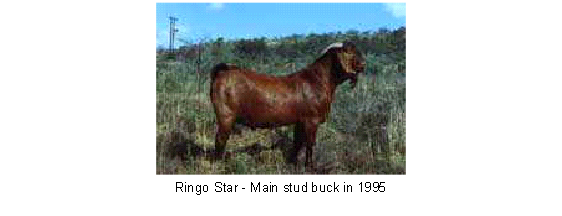
SIZE
The commercial goat farmer can cross-breed
Kalahari Reds to improve the carcass mass of the indigenous goats worldwide.
They have a very long deep body, which gives them excellent mobility. As
they are taller than most of the other goats they can take advantage of
more feed. Their carcass size is similiar to that of the SA Boer goat. The
average weight of a ram is as much as 250 pound, while ewes reach 165 pounds.
Kids grow fast. In Australia young kids show weight gains of 3.3 pound per
week, with some even exceeding 0,880 pound per day.
The commercial goat farmer can cross-
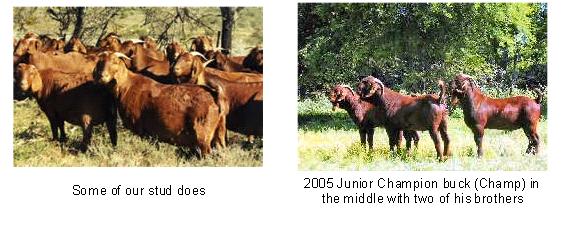
COLOUR
Kalahari Reds can be used to give goats worldwide a uniform, solid red colour, with all the unique advantages that this brings. Their earthy colour provides a good camouflage that protects them from predators. White kids would be seen easily by foxes, pigs and eagles. They are fully pigmented, and therefore able to endure heat and strong sunshine. Their dark coats and long ears provide good heat resistance, and they will therefore feed for longer during the heat of the day, which ultimately means higher weight gains.
Kalahari Reds can be used to give goats worldwide a uniform, solid red colour, with all the unique advantages that this brings. Their earthy colour provides a good camouflage that protects them from predators. White kids would be seen easily by foxes, pigs and eagles. They are fully pigmented, and therefore able to endure heat and strong sunshine. Their dark coats and long ears provide good heat resistance, and they will therefore feed for longer during the heat of the day, which ultimately means higher weight gains.
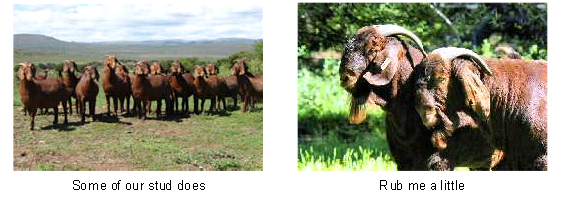
HARDINESS
Kalahari Reds are ideally suited to the harsh and outstretched conditions worldwide. In South Africa they are bred in arid, semi-desert areas.
To prevail under these conditions animals must be sun-resistant and
hardy. Over the years, a natural selection process has ensured that only
the fittest animals have survived, and very little artificial selection
took place. Their excellent mobility allows them to walk far in search of
food and water. They feed on a vast variety of plants. The limited use of
vaccines make the production of originally produced meat possible. A further
bonus is lean meat with an excellent taste and texture.
Kalahari Reds are ideally suited to the harsh and outstretched conditions worldwide. In South Africa they are bred in arid, semi-
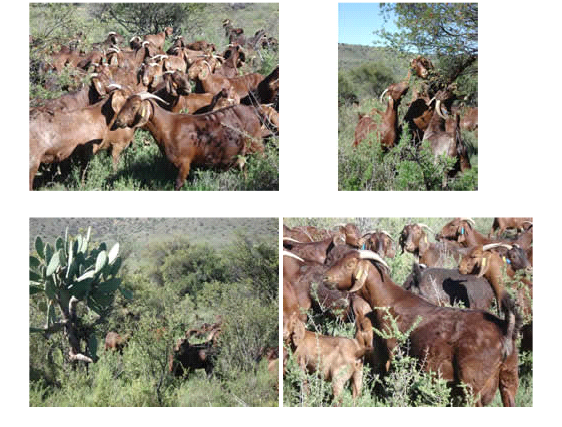
MOTHER ABILITIES
Ewes have excellent mothering instincts, and lamb right in the veld and raise their kids there. No labourers are needed to assist ewes to find their young. In South Africa selection is made strongly in favour of these attributes because kids that are properly cared for by their mothers will do likewise for their own progeny. Through natural selection processes, only the fittest mothers have survived. The ewes are fertile and produce plenty of milk, and as a result, the kids grow fast. Breeders select for twins that are usually of equal strength. Generally, newborn kids are strong and have a strong urge to suck. They herd well, and animlas flock together. They breed all year round, and will kid three times in two years.
In 2000 we decided
that the future of the Kalahari Reds and the Ennobled Boer Goat lie overseas.
All foreigners request detailed records and we have registered all
our stud animals with STUDBOOK.
The past few years
a lot of breeding material have been exported to other countries like Botswana,
Nigeria, Malaysia; embryo's have been exported to Australia, Brazil
and Malaysia and semen to Malaysia. The Kalahari Reds are in demand all
over the world and if you do not want to stay behind in the breeding you
must obtain stock from these oustanding bloodlines.
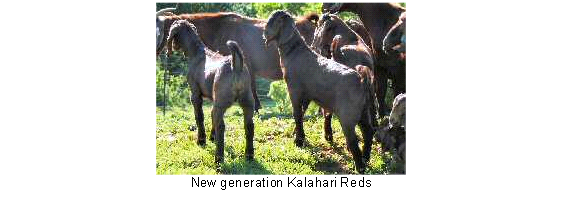
The hard work,
ethic and extreme dedication to quality and improvement which inspired Jordania
Embryo and Live Export Centre to begin its quest is just what will keep
it ahead of the field. For many, many years to come.
For further information
please contact:
Tollie Jordaan
PO Box 377
Somerset East 5850
SOUTH AFRICA
Tollie Jordaan
PO Box 377
Somerset East 5850
SOUTH AFRICA
Tel : +27 42 2432157
Fax: +27 24 2431715
Cell: 082 499 6609 (no
cell reception on the farm)
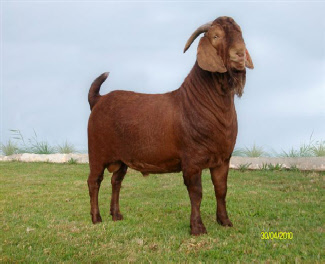
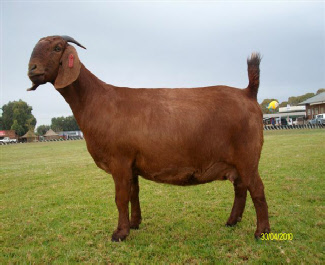
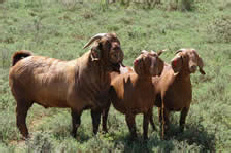
Diamond - Grand Champion
buck 2007
Tenk - Grand Champion
buck 2009
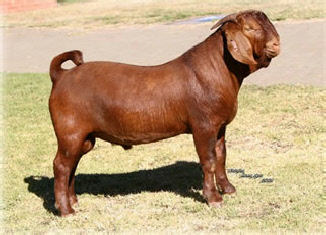
Spot - Reserve Junior
Champion buck 2010
